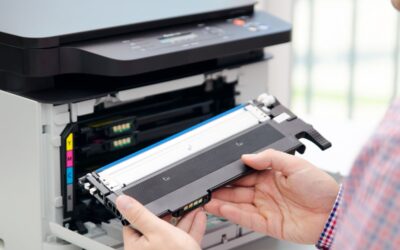However, letter size (8.5 x 11 inches) is more prevalent in North America. Paper A4 measures approximately 210 mm by 297 mm or 8.27 inches by 11.69 inches.
A4 printers are widely used in offices, homes, and various professional settings to produce documents, graphics, and other printed materials. They come in several types and technologies, including inkjet, laser, and even multifunction printers that can scan, copy, and sometimes fax on one device.
Here are some key features and considerations for A4 printers:
Inkjet vs. Laser:
A4 printers are available in inkjet and laser variations. Inkjet printers use liquid ink sprayed onto paper to create images and text. Laser printers use a toner cartridge that applies dry powder to the paper and fuses it with heat. Inkjet printers are often more affordable upfront, while laser printers are known for their fast printing speeds and high-quality text output.
Color vs. Monochrome:
A4 printers can be color or monochrome (black and white). Color printers produce vibrant, full-color prints for presentations, photos, and marketing materials. Monochrome printers are more suited to text-heavy documents and often have faster printing speeds.
Print Speed:
Print speed varies among A4 printers. Laser printers have faster print speeds than inkjet printers. Print speed is usually measured in pages per minute (ppm) and can vary based on whether you print in color or monochrome.
Resolution:
Resolution refers to the sharpness and detail of the printed output. It is measured in dots per inch (DPI). Higher DPI values result in crisper and more detailed prints. A higher resolution is especially critical for printing images or graphics.
Connectivity:
A4 printers have various connectivity options, including USB, Ethernet, Wi-Fi, and Bluetooth. Modern printers often support wireless printing, allowing you to print directly from your smartphone, tablet, or laptop without connecting via cables.
Multifunction Features:
Many A4 printers are multifunction devices that offer additional functionalities such as scanning, copying, and sometimes faxing. These all-in-one printers can save space for home offices or small businesses.
Paper Handling:
A4 printers handle different paper sizes and types, including envelopes, labels, and cardstock. Some printers have multiple paper trays for convenience and can automatically print on both sides of the paper (duplex printing).
Cost Considerations:
When choosing an A4 printer, consider the upfront and ongoing costs. These costs include ink or toner cartridge replacements and maintenance kits. Some printers might have higher initial costs but lower ongoing costs, while others might be the reverse.
Before purchasing an A4 printer, assess your specific printing needs. Consider factors such as the volume of printing you’ll be doing, whether you need color or monochrome printing, the types of documents you’ll produce, and your budget. Reviewing and comparing different printer models can help you make an informed decision that suits your requirements.
Should I lease or purchase my A4 printer?
Leasing an A4 printer can offer several advantages, depending on your specific needs and circumstances. Here are five reasons to lease an A4 printer:
- Cost Management and Predictability: Leasing your printer allows you to spread the cost over a fixed period, typically a few years. This can make budgeting for your printing needs easier, as you’ll have consistent monthly payments. It also helps you avoid significant upfront expenses, which might be more challenging for small businesses or individuals.
- Access to Advanced Technology: Printing industry technology is evolving rapidly. By leasing, you can regularly upgrade to the latest printer models with the newest features, better performance, and improved efficiency. This is particularly critical if your printing requirements demand high-quality outputs or specific functionalities.
- Maintenance and Support: Many leasing agreements include service and technical support. If the printer malfunctions or requires repairs, the leasing company typically covers the costs and assists. This ensures your printer remains operational and minimizes downtime, which is crucial for businesses.
- Tax Benefits: Lease payments for business equipment, including printers, are often considered operating expenses and may be tax-deductible. Consult with a tax professional to understand the specific tax benefits leasing a printer might offer in your situation.
- Flexible Upgrades and Options: Leasing provides flexibility to adapt to changing needs. If your printing volume increases or your requirements vary, you can often upgrade to a more suitable printer without selling your old equipment. Additionally, leasing agreements can include options for buying the equipment at the end of the lease term if you decide to keep it.

However, while leasing has several benefits, it’s essential to carefully evaluate the terms of the lease agreement before committing.
Three considerations to print ownership:
- Total cost of ownership: Assess the total cost of ownership, including lease payments, maintenance costs, and potential renewal fees, to determine whether leasing is cost-effective for your situation.
- Lease duration and terms: Pay attention to the lease duration and terms. Some leases might lock you into a longer-term commitment, which could become problematic if your printing needs change unexpectedly.
- Equipment return conditions: Understand the requirements under which you will return the printer at the end of the lease. Ensure you maintain the printer well to avoid additional charges for excessive wear and tear.
Ready to get started?
Choose a reputable leasing company that offers reliable equipment and transparent terms. Research customer reviews and ask for references if needed. BDS is the #1 Print provider in New England and Florida, contact us today to get started!






